This blog is now hosted by Squarespace. No more updates will be posted here.
Please now use either of the following URLs:
http://www.bluebirding.co.uk
http://bluebirding.squarespace.com
22 January 2011
18 January 2011
Miracle in the Marshes of Iraq.
Broadcast on BBC TWO this evening, Miracle in the Marshes of Iraq was a wonderful example of wildlife documentary making.
The program presented the work of Azzam Alwash, a man who grew up with the Mesopotamian Marshes in his soul, and a man blessed with the vision to restore the vast area - once dominant in south east Iraq - to its former glory. In the 1990's Saddam Hussein decided that in order to eradicate the indigenous people of the wetlands he would drain the region - turning it into a naked dustbowl. The rivers that once supplied the wetlands with water, like the Euphrates, were placed in straight-jackets and a network of canals was built to channel water towards the Gulf instead of the central marshes.
Today, Alwash is overseeing the return to life of the area. Birds, mammals, fish... the people. Here it all seemed as one. A way of life restored for everything.
Before this evening I had absolutely no idea the Mesopotamian Marshes ever existed, and no idea about the work that is taking place to restore them. Now I am captivated and will be donating to Nature Iraq, the organization Alwash established to give the work its core structure.
The return of birds shown in the documentary, from the characterful Pied Kingfisher, to the elegant Black-winged Stilt, to the Greater Flamingos, Iraq Babbler and mostly heartening of all... the Basra Reed Warbler (almost endemic to the region) demonstrate that if you provide the environment they will come. The most amazing sight, however, was a flock of c.40,000 Marbled Teal, a species last seen in the country over 20 years ago. The look on the film maker's, and Alwash's face, was unforgettable. He could see the past erupting into life and could not contain his delight.
Of course, the film was careful to highlight what a dangerous place Iraq remains, and we were never far away from a weapon, or bunker, or armoured vehicle. This stuff demands attention, too. If only the country could stabilise sufficiently that tourism could gain even a slender foothold, I've no doubts these wetlands would represent an essential 'eco-tourism' destination. Sure, even from a environmental point of view the comeback is a slow one ("two steps forward, once step back... but on the right track", as Alwash put it). For example there are issues with maintaining sufficient water supply to allow full restoration of the marshes. Dams upstream in Syria and Turkey rob the region of the water supply it once enjoyed, and so Alwash has had to get creative with the water trapped in Saddam's canal network. But still... the place looked, frankly, awesome.
A glowing word, also, for the film makers themselves. There was a well thought out narrative to the program, no talking down to the audience, and the problems were laid out as openly as the successes.
Here is a link the program in the BBC's iPlayer - http://www.bbc.co.uk/iplayer/episode/b00xxf9f/hd/Natural_World_20102011_Miracle_in_the_Marshes_of_Iraq/
If you need to put a spring in your step this winter, look no further.
Birding in Iraq.
What a prospect.
The program presented the work of Azzam Alwash, a man who grew up with the Mesopotamian Marshes in his soul, and a man blessed with the vision to restore the vast area - once dominant in south east Iraq - to its former glory. In the 1990's Saddam Hussein decided that in order to eradicate the indigenous people of the wetlands he would drain the region - turning it into a naked dustbowl. The rivers that once supplied the wetlands with water, like the Euphrates, were placed in straight-jackets and a network of canals was built to channel water towards the Gulf instead of the central marshes.
Today, Alwash is overseeing the return to life of the area. Birds, mammals, fish... the people. Here it all seemed as one. A way of life restored for everything.
Before this evening I had absolutely no idea the Mesopotamian Marshes ever existed, and no idea about the work that is taking place to restore them. Now I am captivated and will be donating to Nature Iraq, the organization Alwash established to give the work its core structure.
The return of birds shown in the documentary, from the characterful Pied Kingfisher, to the elegant Black-winged Stilt, to the Greater Flamingos, Iraq Babbler and mostly heartening of all... the Basra Reed Warbler (almost endemic to the region) demonstrate that if you provide the environment they will come. The most amazing sight, however, was a flock of c.40,000 Marbled Teal, a species last seen in the country over 20 years ago. The look on the film maker's, and Alwash's face, was unforgettable. He could see the past erupting into life and could not contain his delight.
Of course, the film was careful to highlight what a dangerous place Iraq remains, and we were never far away from a weapon, or bunker, or armoured vehicle. This stuff demands attention, too. If only the country could stabilise sufficiently that tourism could gain even a slender foothold, I've no doubts these wetlands would represent an essential 'eco-tourism' destination. Sure, even from a environmental point of view the comeback is a slow one ("two steps forward, once step back... but on the right track", as Alwash put it). For example there are issues with maintaining sufficient water supply to allow full restoration of the marshes. Dams upstream in Syria and Turkey rob the region of the water supply it once enjoyed, and so Alwash has had to get creative with the water trapped in Saddam's canal network. But still... the place looked, frankly, awesome.
A glowing word, also, for the film makers themselves. There was a well thought out narrative to the program, no talking down to the audience, and the problems were laid out as openly as the successes.
Here is a link the program in the BBC's iPlayer - http://www.bbc.co.uk/iplayer/episode/b00xxf9f/hd/Natural_World_20102011_Miracle_in_the_Marshes_of_Iraq/
If you need to put a spring in your step this winter, look no further.
Birding in Iraq.
What a prospect.
16 January 2011
Hugely Exciting Garden Birds.
15 January 2011
Goldeneye.
09 January 2011
Sharpness.
In glorious sunshine, a poke around the habitats at Sharpness at high tide (1030hrs to approximately 1300hrs). Maybe something good would come up river, or on the turn?
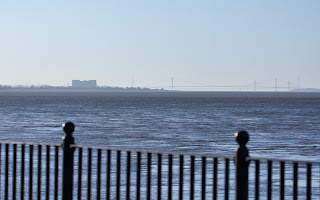
No. Maybe a Black Redstart would show up?
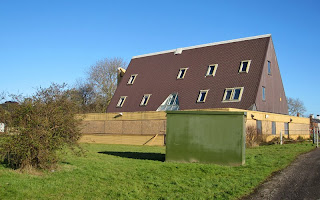
No. But there were plenty of...
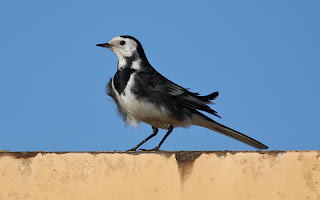
Still, the Pied Wags plus six others for the year list (now 74) in the form of (and in chronological order*) Pied Wagtail (lol), Wren (lol), Reed Bunting, Grey Wagtail, Goldfinch, Rock Pipit (the 'double picture' below is of the same bird) and Redshank. Nothing remarkable, but in this weather you really can't avoid a good view of a bird. Six Cormorants were observed flying down river, and many Gulls (mostly Common) were seen to float down on the tide along with two Shelduck. The Redshanks (two birds) showed well just as the mud began to expose, as did two Curlews. Finally, a flock of c.10 Linnets were seen a number of times. Too wary to pin down for a photograph.
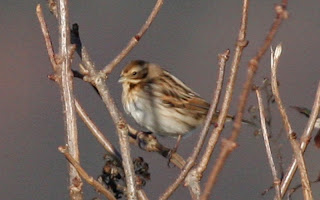
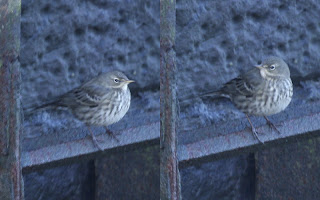
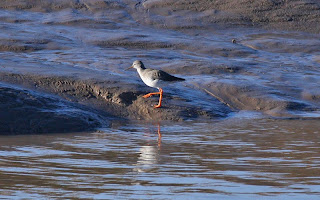
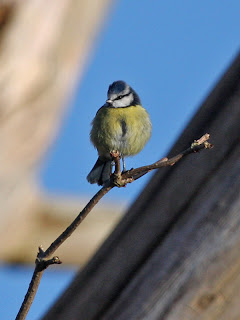
I love the scrub area just beyond the Ned West building. It's a great spot to watch the various Tits and Finches going about their business.
Between Berkeley and Sharpness I stopped to watch a couple of Kestrels (1m/1f) engaged in battle / courtship. They were alternately ambushing each other over the right to sit atop this electricity pylon.
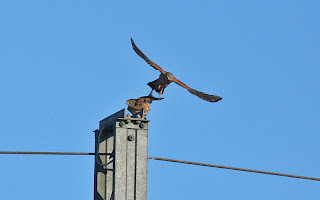
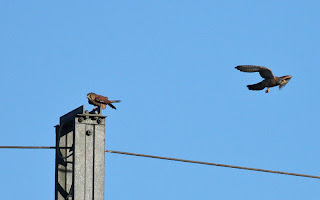
*I always keep my year list in the precise order I see each new bird, which makes a notebook essential. One can easily forget the order after the fact.

No. Maybe a Black Redstart would show up?

No. But there were plenty of...

Still, the Pied Wags plus six others for the year list (now 74) in the form of (and in chronological order*) Pied Wagtail (lol), Wren (lol), Reed Bunting, Grey Wagtail, Goldfinch, Rock Pipit (the 'double picture' below is of the same bird) and Redshank. Nothing remarkable, but in this weather you really can't avoid a good view of a bird. Six Cormorants were observed flying down river, and many Gulls (mostly Common) were seen to float down on the tide along with two Shelduck. The Redshanks (two birds) showed well just as the mud began to expose, as did two Curlews. Finally, a flock of c.10 Linnets were seen a number of times. Too wary to pin down for a photograph.




I love the scrub area just beyond the Ned West building. It's a great spot to watch the various Tits and Finches going about their business.
Between Berkeley and Sharpness I stopped to watch a couple of Kestrels (1m/1f) engaged in battle / courtship. They were alternately ambushing each other over the right to sit atop this electricity pylon.


*I always keep my year list in the precise order I see each new bird, which makes a notebook essential. One can easily forget the order after the fact.
08 January 2011
Water Park West.
Always good for a few hours birding, I took advantage of a necessary visit to the Outdoor Store to drop in on a few of the key pits before the football started in the afternoon. I hadn't birded there since last Spring, so I was concerned I'd spend more time trying to remember the various good access points to the pits than actually birding. As it turned out, it was like riding a bike... you never forget!
Of course, every pit had varying numbers of Gadwall, Tufted Duck, Pochard and all but pit 12 contained Wigeon. Without any given purpose, I won't count Gulls (scan through them, of course)... so let's just say there were lots of each pretty much everywhere except GBBGs, or which I saw very few.
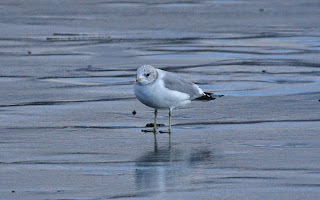
Pit 12 brought me my first Common Gull of the year (photo above of the first one I clapped eyes on) alongside my first Little Grebe, Great Crested Grebes and Goldeneye (3m/1f) of the year. There were perhaps 20 Mute Swans present, frequently taking flight and - every time - amusing as they attempted touchdown on the ice. Plenty of Black-headed Gulls but no candidates for Med.
Pit 17. A Great Spotted Woodpecker (seem to be running into these all over the place recently) made a racket along the shore. There were five Goosander (3m/2f) loitering along the far side.
On pit 16 there were four more Goldeneye (3m/1f). Around the edge I spotted a Treecreeper and a Goldcrest (although I only saw one there were more) - a welcome tick.
Pit 74. More Goldeneye (4m/6f), c.15 Cormorants often in flight. A Buzzard flew over the area and stirred great numbers of Wigeon into flight along with some Lapwing. A smaller flock of something took flight, too, but the view was simply too distant to identify them. I made my way around to the hides, but they didn't help. One Black-headed Gull's pursuit of a young Herring Gull (which had caught a small fish) was probably the highlight. Like a dogfight.
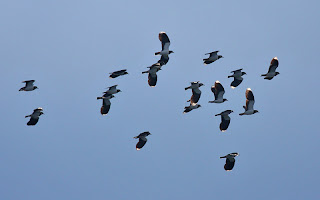
En route back to the car from the hides a Buzzard provided great views as it circled and called above the field I was walking past. It didn't seem to mind my presence and flew towards me a number of times, affording me the luxury of photographing a raptor head on rather than the usual rear view as they retreat to a 'safe' distance.
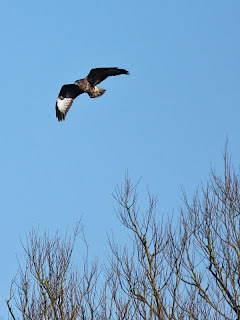

Final stop for today was pit 41, site of a few drake Smew sightings recently. Alas, a couple of scans revealed no Smew but I did pick up three Red-crested Pochard (1m/2f) for the year list and get good views of a small flock of Siskin feeding in trees along the shore.

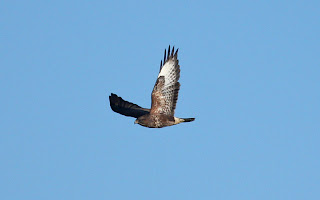
Plenty of pits still to investigate, and plenty of Winter still to go. Many of the larger areas of water are still partially frozen.
Year list stands at 67 this evening. There are some differences in content (still no Wren or Pied Wagtail this year!), but I'm running pretty much parallel with last year in terms of numbers.
Of course, every pit had varying numbers of Gadwall, Tufted Duck, Pochard and all but pit 12 contained Wigeon. Without any given purpose, I won't count Gulls (scan through them, of course)... so let's just say there were lots of each pretty much everywhere except GBBGs, or which I saw very few.

Pit 12 brought me my first Common Gull of the year (photo above of the first one I clapped eyes on) alongside my first Little Grebe, Great Crested Grebes and Goldeneye (3m/1f) of the year. There were perhaps 20 Mute Swans present, frequently taking flight and - every time - amusing as they attempted touchdown on the ice. Plenty of Black-headed Gulls but no candidates for Med.
Pit 17. A Great Spotted Woodpecker (seem to be running into these all over the place recently) made a racket along the shore. There were five Goosander (3m/2f) loitering along the far side.
On pit 16 there were four more Goldeneye (3m/1f). Around the edge I spotted a Treecreeper and a Goldcrest (although I only saw one there were more) - a welcome tick.
Pit 74. More Goldeneye (4m/6f), c.15 Cormorants often in flight. A Buzzard flew over the area and stirred great numbers of Wigeon into flight along with some Lapwing. A smaller flock of something took flight, too, but the view was simply too distant to identify them. I made my way around to the hides, but they didn't help. One Black-headed Gull's pursuit of a young Herring Gull (which had caught a small fish) was probably the highlight. Like a dogfight.

En route back to the car from the hides a Buzzard provided great views as it circled and called above the field I was walking past. It didn't seem to mind my presence and flew towards me a number of times, affording me the luxury of photographing a raptor head on rather than the usual rear view as they retreat to a 'safe' distance.


Final stop for today was pit 41, site of a few drake Smew sightings recently. Alas, a couple of scans revealed no Smew but I did pick up three Red-crested Pochard (1m/2f) for the year list and get good views of a small flock of Siskin feeding in trees along the shore.


Plenty of pits still to investigate, and plenty of Winter still to go. Many of the larger areas of water are still partially frozen.
Year list stands at 67 this evening. There are some differences in content (still no Wren or Pied Wagtail this year!), but I'm running pretty much parallel with last year in terms of numbers.
05 January 2011
BUBO Lists.
I've done some thinking, head scratching, and list checking, and now have 8 lists on there! All BOU. I'm quite confident they're all in good shape.
- Britain Life: 226
- Britain 2010: 213
- Gloucestershire Life: 169
- WWT Slimbridge Life: 126
- Isles of Scilly Life: 115
- Witcombe Reservoirs Life: 64
- Britain 2011: 57
- Garden List Life: 39
- Britain Life: 226
- Britain 2010: 213
- Gloucestershire Life: 169
- WWT Slimbridge Life: 126
- Isles of Scilly Life: 115
- Witcombe Reservoirs Life: 64
- Britain 2011: 57
- Garden List Life: 39
03 January 2011
Lesser Scaup-fest.
One Slimbridge collection bird (left), one wild bird (right):
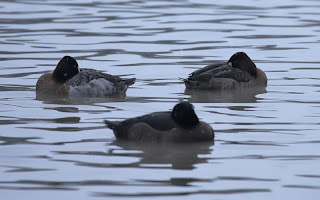
The collection bird is older, and so is greyer. It also (even in my lousy photograph) clearly possesses a brighter yellow iris. In comparison the wild bird has a dull iris - indicative of a first winter bird.
Although plumage and head shape were always available for inspection, I was fearful that the bird would keep its most prized distinguishing feature tucked away for the duration of my visit. However, I'm pleased to report that it did raise its head and have a stretch. It was snowing onsite so the photographs are as good as I could comfortably manage. The first image shows the white wing bar trailing into grey through the primaries.
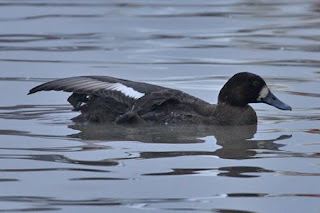
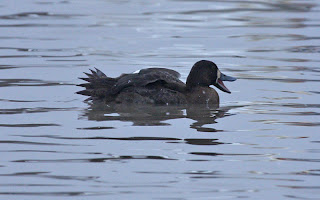
As I was leaving, I photographed it swimming about:
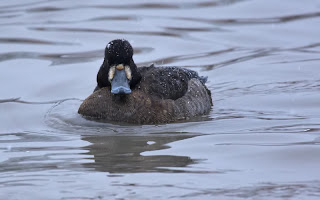
I also decided that the male Mandarin Duck on the Pen was fair game for a tick. The Slimbridge wardens seem content that it's wild.
In the morning I popped into Coombe Hill Meadows and added a few bits and bobs to my year list (which I'm not interested in!). The most pleasing (of nothing spectacular) were Treecreeper and Great Spotted Woodpecker. 55 now.
Also onsite - from the Grundon Hide - were over 100 Greylags, a few Canada Geese, a distant flock of Wigeon (couple of hundred birds perhaps), two Lapwing, three Buzzards and a fly through Sparrowhawk.
I was pleased to see that there is now a longer raised walkway allowing access to the Grundon Hide from the canal towpath. This should mean that when the fields next flood, the hide will still be accessible.

The collection bird is older, and so is greyer. It also (even in my lousy photograph) clearly possesses a brighter yellow iris. In comparison the wild bird has a dull iris - indicative of a first winter bird.
Although plumage and head shape were always available for inspection, I was fearful that the bird would keep its most prized distinguishing feature tucked away for the duration of my visit. However, I'm pleased to report that it did raise its head and have a stretch. It was snowing onsite so the photographs are as good as I could comfortably manage. The first image shows the white wing bar trailing into grey through the primaries.


As I was leaving, I photographed it swimming about:

I also decided that the male Mandarin Duck on the Pen was fair game for a tick. The Slimbridge wardens seem content that it's wild.
In the morning I popped into Coombe Hill Meadows and added a few bits and bobs to my year list (which I'm not interested in!). The most pleasing (of nothing spectacular) were Treecreeper and Great Spotted Woodpecker. 55 now.
Also onsite - from the Grundon Hide - were over 100 Greylags, a few Canada Geese, a distant flock of Wigeon (couple of hundred birds perhaps), two Lapwing, three Buzzards and a fly through Sparrowhawk.
I was pleased to see that there is now a longer raised walkway allowing access to the Grundon Hide from the canal towpath. This should mean that when the fields next flood, the hide will still be accessible.
02 January 2011
35.
These are the birds I aim to see for the first time (in the wild) in 2011. Although other stuff will inevitably crop up, these will be the priority:
Bean Goose
Ruddy Shelduck
Eider
Velvet Scoter
Slavonian Grebe
Red-necked Grebe
White-tailed Eagle
Hen Harrier
Honey Buzzard
Rough-legged Buzzard
Stone Curlew
Dotterel
Jack Snipe
Arctic Skua
Caspian Gull
Glaucous Gull
Roseate Tern
Long-eared Owl
Tawny Owl
Hoopoe
Lesser Spotted Woodpecker
Wryneck
Woodlark
Shore Lark
Water Pipit
Nightingale
Ring Ouzel
Grasshopper Warbler
Crested Tit
Bearded Tit
Penduline Tit
Chough
Common/Mealy Redpoll
Snow Bunting
Cirl Bunting
Bean Goose
Ruddy Shelduck
Eider
Velvet Scoter
Slavonian Grebe
Red-necked Grebe
White-tailed Eagle
Hen Harrier
Honey Buzzard
Rough-legged Buzzard
Stone Curlew
Dotterel
Jack Snipe
Arctic Skua
Caspian Gull
Glaucous Gull
Roseate Tern
Long-eared Owl
Tawny Owl
Hoopoe
Lesser Spotted Woodpecker
Wryneck
Woodlark
Shore Lark
Water Pipit
Nightingale
Ring Ouzel
Grasshopper Warbler
Crested Tit
Bearded Tit
Penduline Tit
Chough
Common/Mealy Redpoll
Snow Bunting
Cirl Bunting
1st January.
I'd hoped to spot the Lesser Scaup on the Rushy at Slimbridge, but couldn't find it. As it turns out, neither could many better birders than me. I did get a much better look at that other Greater Scaup (the one I thought was a female).
Definitely a male. Blaze not big enough for a female, I was told... and now I've seen it in clear conditions (no fog!) it has the beginnings of pretty strong grey vermiculation on it's back. Also, one could - on occasion - catch a hint of green on it's head. Indeed, I think this photo shows the green - at least it does on my screen.
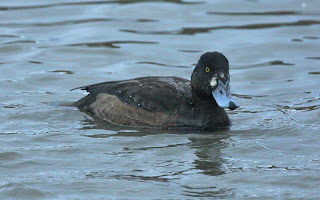
I picked up 43 species for my 2011 year list - including a great Redhead Smew from the Zeiss Hide. Here is a typically spectacular photograph of it:
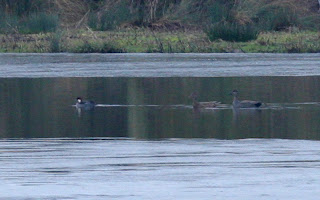
Still, this year isn't going to be about frantically adding to a year list, rather (in the majority) about finding and seeing a list of 35 birds I've never seen before. I'll post the list very soon.
Definitely a male. Blaze not big enough for a female, I was told... and now I've seen it in clear conditions (no fog!) it has the beginnings of pretty strong grey vermiculation on it's back. Also, one could - on occasion - catch a hint of green on it's head. Indeed, I think this photo shows the green - at least it does on my screen.

I picked up 43 species for my 2011 year list - including a great Redhead Smew from the Zeiss Hide. Here is a typically spectacular photograph of it:

Still, this year isn't going to be about frantically adding to a year list, rather (in the majority) about finding and seeing a list of 35 birds I've never seen before. I'll post the list very soon.
01 January 2011
Sex Change.
30 December 2010
Devon + Fog.
With time running out, it was a shameless attempt to add to my year list. I had to go today - despite the blasted fog... New Year's Eve being full of celebrations and all that jazz.
Mostly frustrating, to be honest.
At Exminster Marshes between 0900hrs and 1030hrs, there was no sign of any Harriers. Teal, Wigeon, Shoveler, Black-tailed Godwit, Redshank, Lapwing, one Grey Heron, one Kestrel, one Buzzard picking apart a prey item, Redwing, various Tits, one Bunting sp., Grey Plovers. Alas, I could not find the Water Pipits... or they wouldn't find me. Oh, and there were Canada Geese - truly a rarity.
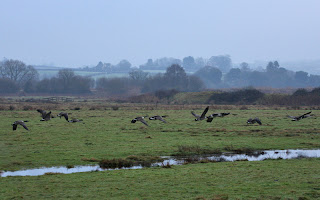
I know that before midday a female Marsh Harrier, ringtail Hen Harrier and a couple of Bitterns showed, but I think (or hope, actually) that I had moved on by then.
Undeterred, I moved onto Dawlish. Not the Warren, but a two and a half hour stint atop Langstone Rock. This was the most profitable portion of the day. The sea was rough but there was plenty of action. At least 30 Gannets, 5 Oystercatchers flew past, many Great-crested Grebes and one Little Grebe were the run of the mill stuff. I didn't see any Black-necked or Slavonian Grebes, or - most disappointingly - no Eiders. Still, there was a flock (c.15 birds) of Common Scoter (year tick 211; lifer 223) with another group of six or seven birds flying past, four Black-throated Divers (year tick 213; lifer 225) on the water and one Red-throated Diver (year tick 212; lifer 224). I expect there were more about but I'm quite the novice at sea watching. Many Razorbills flew past. A few landed on the water, some of which I reckoned were Guillemots (a hoped for year tick) but I just wasn't sure. I don't think I would've been able to pick out the female Surf Scoter had I seen it (I don't think I did). I thoroughly enjoyed the sea-watch though, and will definitely do it more regularly next year - ideally before the end of winter.

There were also trains. Frequent trains.
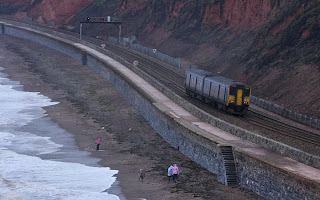
The fog wasn't proving a problem, so at about 1330hrs I decided to hit the last big target of the day - Cirl Buntings. Off I went to Labrador Bay. Hmmmmmmmmmmmmmmmmm. Upon arrival it became clear that all the fog had congregated there. It was horrendous. One couldn't see more than a few meters ahead, it was very cold and the wind was howling. In short there was no chance of seeing a Cirl. Even being outside was quite a challenge, and not in the way that it's a challenge to get out and about in snowy conditions. This was truly unpleasant. The Cirls will have to wait for another day. On the plus side, at least I know the way.
I decided to go back to Exminster Marshes to use the remaining daylight hoping the Hen Harrier would show for me. Needless to say it did not, and neither did the Water Pipits. I decided that if I strayed too far from the scrapes (to find the redhead Smew, for example) I would miss something. In retrospect I can safely say I would've missed nothing. Except Starlings...
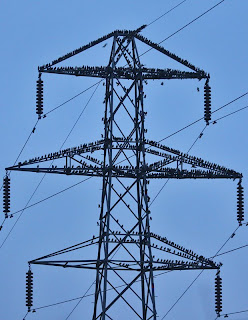
Should've gone back to Dawlish, really. The Exe area is smashing for birds though. Part of the problem is choosing where to go - so many places to pick from. I think my next sortie will involve a good study of the estuary, another pop at the Cirl Buntings and more time on Langstone Rock. Orcombe Point and Broadsands are two other spots I hear good things about.
A mixed day. I'm pleased to have added three more birds to both my year list and life list, but to be honest I had hoped for more. I seem fated to forever miss Hen Harriers. I think my birding new year resolution has to be to make better decisions. I know that it's a lot to ask to get everything one wants in one day trip, but I rarely seem to get above a 50% 'hit rate', which IMO needs to be improved in 2011.
So (of desirables) did see:
Common Scoter
Red-throated Diver
Black-throated Diver
Didn't see:
Cirl Bunting (weather prevented it)
Eider
Slavonian Grebe
Hen Harrier
Water Pipit
Mostly frustrating, to be honest.
At Exminster Marshes between 0900hrs and 1030hrs, there was no sign of any Harriers. Teal, Wigeon, Shoveler, Black-tailed Godwit, Redshank, Lapwing, one Grey Heron, one Kestrel, one Buzzard picking apart a prey item, Redwing, various Tits, one Bunting sp., Grey Plovers. Alas, I could not find the Water Pipits... or they wouldn't find me. Oh, and there were Canada Geese - truly a rarity.

I know that before midday a female Marsh Harrier, ringtail Hen Harrier and a couple of Bitterns showed, but I think (or hope, actually) that I had moved on by then.
Undeterred, I moved onto Dawlish. Not the Warren, but a two and a half hour stint atop Langstone Rock. This was the most profitable portion of the day. The sea was rough but there was plenty of action. At least 30 Gannets, 5 Oystercatchers flew past, many Great-crested Grebes and one Little Grebe were the run of the mill stuff. I didn't see any Black-necked or Slavonian Grebes, or - most disappointingly - no Eiders. Still, there was a flock (c.15 birds) of Common Scoter (year tick 211; lifer 223) with another group of six or seven birds flying past, four Black-throated Divers (year tick 213; lifer 225) on the water and one Red-throated Diver (year tick 212; lifer 224). I expect there were more about but I'm quite the novice at sea watching. Many Razorbills flew past. A few landed on the water, some of which I reckoned were Guillemots (a hoped for year tick) but I just wasn't sure. I don't think I would've been able to pick out the female Surf Scoter had I seen it (I don't think I did). I thoroughly enjoyed the sea-watch though, and will definitely do it more regularly next year - ideally before the end of winter.

There were also trains. Frequent trains.

The fog wasn't proving a problem, so at about 1330hrs I decided to hit the last big target of the day - Cirl Buntings. Off I went to Labrador Bay. Hmmmmmmmmmmmmmmmmm. Upon arrival it became clear that all the fog had congregated there. It was horrendous. One couldn't see more than a few meters ahead, it was very cold and the wind was howling. In short there was no chance of seeing a Cirl. Even being outside was quite a challenge, and not in the way that it's a challenge to get out and about in snowy conditions. This was truly unpleasant. The Cirls will have to wait for another day. On the plus side, at least I know the way.
I decided to go back to Exminster Marshes to use the remaining daylight hoping the Hen Harrier would show for me. Needless to say it did not, and neither did the Water Pipits. I decided that if I strayed too far from the scrapes (to find the redhead Smew, for example) I would miss something. In retrospect I can safely say I would've missed nothing. Except Starlings...

Should've gone back to Dawlish, really. The Exe area is smashing for birds though. Part of the problem is choosing where to go - so many places to pick from. I think my next sortie will involve a good study of the estuary, another pop at the Cirl Buntings and more time on Langstone Rock. Orcombe Point and Broadsands are two other spots I hear good things about.
A mixed day. I'm pleased to have added three more birds to both my year list and life list, but to be honest I had hoped for more. I seem fated to forever miss Hen Harriers. I think my birding new year resolution has to be to make better decisions. I know that it's a lot to ask to get everything one wants in one day trip, but I rarely seem to get above a 50% 'hit rate', which IMO needs to be improved in 2011.
So (of desirables) did see:
Common Scoter
Red-throated Diver
Black-throated Diver
Didn't see:
Cirl Bunting (weather prevented it)
Eider
Slavonian Grebe
Hen Harrier
Water Pipit
29 December 2010
Scaup-fest at Slimbridge.
Well, two Scaup.
Slimbridge has delivered the goods recently. Hot on the heels of the Gannet and Woodcock last week, two 1w Greater Scaup were found on the Rushy Pen yesterday. Despite foggy conditions, they were too big a lure.

One male, one female. The male was beginning to show the lovely grey vermiculations typical of an adult bird. It was good to see two examples of the species at an age I'd not seen before. Indeed, in with all the other birds present on the Rushy - particularly all the Tufties - the difference in scale between Scaup and Tufted Duck was extremely apparent. Close views most useful.
My only two previous Scaup sightings were the adult male at Cotwsold Water Park (West) and the female I spotted distantly at sea just off Hinkley Point in Somerset. Both were in March of this year.
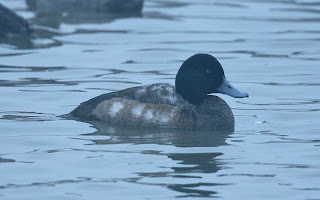
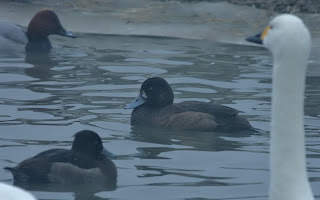
I went down to the Kingfisher Hide, but the Whitefronts were absent, so as a last resort I tried the feeders enroute to the Holden Tower. Not only did the Great Spotted Woodpecker pay me another visit, but the (seemingly) resident Water Rail also showed very well.
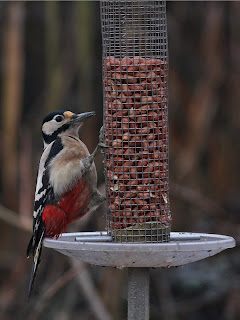
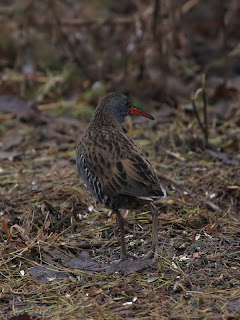
That was my third Water Rail of the year. The first came on January 1st from the 100 Acre viewing platform at Frampton (it stood out on the ice at the rear), and the second came at the second hide down from the road (or first from the beach) at Porth Hellick on Scilly in September.
Slimbridge has delivered the goods recently. Hot on the heels of the Gannet and Woodcock last week, two 1w Greater Scaup were found on the Rushy Pen yesterday. Despite foggy conditions, they were too big a lure.

One male, one female. The male was beginning to show the lovely grey vermiculations typical of an adult bird. It was good to see two examples of the species at an age I'd not seen before. Indeed, in with all the other birds present on the Rushy - particularly all the Tufties - the difference in scale between Scaup and Tufted Duck was extremely apparent. Close views most useful.
My only two previous Scaup sightings were the adult male at Cotwsold Water Park (West) and the female I spotted distantly at sea just off Hinkley Point in Somerset. Both were in March of this year.


I went down to the Kingfisher Hide, but the Whitefronts were absent, so as a last resort I tried the feeders enroute to the Holden Tower. Not only did the Great Spotted Woodpecker pay me another visit, but the (seemingly) resident Water Rail also showed very well.


That was my third Water Rail of the year. The first came on January 1st from the 100 Acre viewing platform at Frampton (it stood out on the ice at the rear), and the second came at the second hide down from the road (or first from the beach) at Porth Hellick on Scilly in September.
24 December 2010
Northwick Warth and Aust Warth.
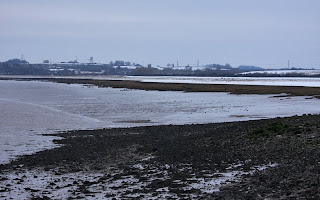
A chilly, snow covered day between the two Severn crossings. I went specifically for the male Merlin, which duly appeared within two seconds of setting up my scope at Aust Warth. I watched (distant views, but passable through the scope) it fly low over the vegetation for about ten seconds, perch briefly and then spring upwards to pursue a Pipit. Then I lost it - and didn't see it again.
A large female Sparrowhawk flew directly overhead, and a Kestrel lazily flew along the shoreline.
I decided to walk down to Northwick Warth to the gate midway along the footpath. From there, at 1110hrs, I observed a large Harrier casually flying NE upriver over the Warth. It wasn't hunting, just 'ambling along'. It flew off towards the first Severn crossing, and out of range. Now, I felt strongly that this bird was a female / juvenile Marsh Harrier. No markings on the tail (absolutely no white rump), consistently very dark, and a noticably heavy (for a Harrier) build. In argument against, and to be honest, lighter markings on the head were hard to discern. But still, the unmarked tail and no white rump sells it for me.
I spoke with another birder who said that a ringtail Hen Harrier had been seen shortly before at New Passage. In addition, RBA has a ringtail Hen Harrier sighted flying NE over Chittering Warth at 1015hrs and Severnside Birds has a shot of an obvious Hen Harrier (probably the same individual). The site reports that the Hen Harrier stayed the afternoon at Aust Warth (from 1340hrs onwards) and also roosted there. So it lingered. Long before that my bird disappeared completely out of sight and for the remaining duration of my visit did not return... so I stick by my identification as a female / juvenile Marsh Harrier.
I'd love what I saw to be the Hen Harrier (it would've been a long overdue lifer), but it wasn't. Infact, given that I chose to visit today I consider myself unfortunate to have missed it. I realise that all this sounds awfully coincidental and that the simplest explanation is that there was no Marsh Harrier. But the thing is... there was. I think a Hen Harrier stayed for the day, and a Marsh Harrier passed through.
I drove down to New Passage hoping to find the Merlin, but the wind was getting up and so the temperature really began to take its toll. Plus, the Merlin didn't show. Finally, another 30 minute stint at Aust Warth was as far as my box of Maltesers would take me. I left 20 minutes (at 1320hrs) before the definite Hen Harrier showed well at Aust! By then, the Marsh Harrier was long gone...
Weatherman says the Sun will come out tomorrow.

23 December 2010
Great Visit to Slimbridge.
Given the weather, the reserve was light on people and heavy on birds. The best combination!
After buying some ace Christmas-but-not-Christmas cards from the shop (and a new feeder), I headed out first to the South Lake. Most of the water was iced over, but there were two oases of water for the birds to use. A good selection of wildfowl - Gadwall, Pintail, Teal, Pochard, Wigeon, Greylags, many Mute Swans with a few Bewicks for good measure.
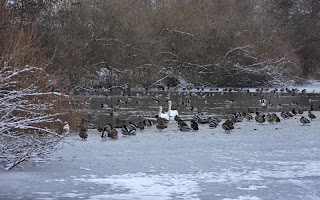
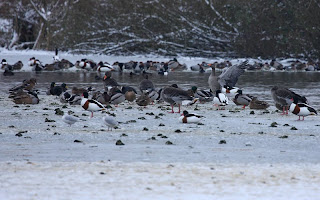
Having enjoyed the luxury of a South Lake hide free of mothers and young children (!!!) for a while, I moved onto the walkway that takes you to the Holden Tower. There was very little (actually, nothing) to see from the Robbie Garnett or Stephen Kirk hides, but the feeders on the other side produced close-up views of a Great Spotted Woodpecker and a decent flock of Long-tailed Tits. All the other usual suspects were present, but I didn't see a Brambling.
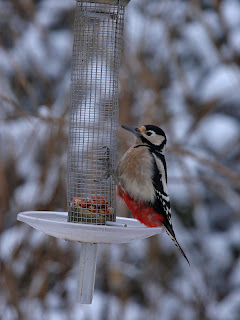
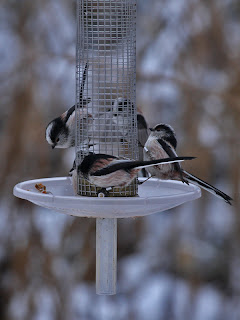
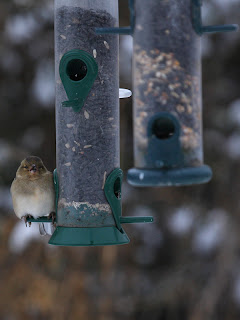
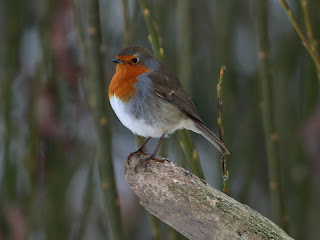
The Woodpecker stayed for a good five or six minutes, but was eventually - and annoyingly - bullied off by...
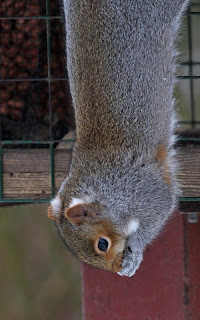
Onto the Holden Tower itself, which was surprisingly pretty full (or perhaps not surprisingly!). There were, apparently, two small (c.20 and c.10 birds) flocks of probable Snow Buntings observed to the right of the Tower. Unfortunately I didn't see them when others did. I did infact see a small flock of something moving North along the Dumbles, but could not claim them as Snow Buntings. I kept up a vigil when the hide emptied, but did not see them again.
Still, Lady Luck certainly didn't abandon me as shortly after the 'Snow Buntings' showed an adult Gannet was seen flying upriver with the tide. Remarkable, and a first for me at Slimbridge - indeed in Gloucestershire. Everyone in the Tower observed the bird flying upriver, but when I was alone I watched it land on the water and begin to (in the main) float back downriver. I tried to photograph it, and although I got nothing of any real worth I was fortunate enough to catch it once with wings outstretched. I've messed about with the image something rotten in Photoshop, and you can clearly see a black tip to the left wing:
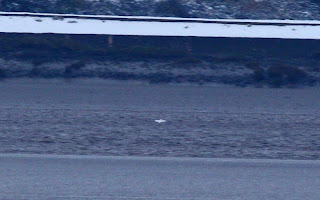
Best was yet to come, though... As I watched the Gannet floating along, Dave Paynter dropped into the Tower to let anyone inside (just me!) know that a Woodcock had been found near the Knott Hide. Dave provided access, and stunning views of the bird were had at a distance of about five yards. Beautifully camouflaged, it didn't move. Behold:
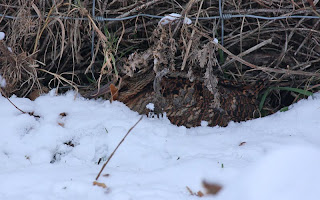
The picture doesn't do the colours justice. Through a telescope it was just gorgeous.
And with that I realised I was really feeling my toes, and so went home to warm up.
After buying some ace Christmas-but-not-Christmas cards from the shop (and a new feeder), I headed out first to the South Lake. Most of the water was iced over, but there were two oases of water for the birds to use. A good selection of wildfowl - Gadwall, Pintail, Teal, Pochard, Wigeon, Greylags, many Mute Swans with a few Bewicks for good measure.


Having enjoyed the luxury of a South Lake hide free of mothers and young children (!!!) for a while, I moved onto the walkway that takes you to the Holden Tower. There was very little (actually, nothing) to see from the Robbie Garnett or Stephen Kirk hides, but the feeders on the other side produced close-up views of a Great Spotted Woodpecker and a decent flock of Long-tailed Tits. All the other usual suspects were present, but I didn't see a Brambling.




The Woodpecker stayed for a good five or six minutes, but was eventually - and annoyingly - bullied off by...

Onto the Holden Tower itself, which was surprisingly pretty full (or perhaps not surprisingly!). There were, apparently, two small (c.20 and c.10 birds) flocks of probable Snow Buntings observed to the right of the Tower. Unfortunately I didn't see them when others did. I did infact see a small flock of something moving North along the Dumbles, but could not claim them as Snow Buntings. I kept up a vigil when the hide emptied, but did not see them again.
Still, Lady Luck certainly didn't abandon me as shortly after the 'Snow Buntings' showed an adult Gannet was seen flying upriver with the tide. Remarkable, and a first for me at Slimbridge - indeed in Gloucestershire. Everyone in the Tower observed the bird flying upriver, but when I was alone I watched it land on the water and begin to (in the main) float back downriver. I tried to photograph it, and although I got nothing of any real worth I was fortunate enough to catch it once with wings outstretched. I've messed about with the image something rotten in Photoshop, and you can clearly see a black tip to the left wing:

Best was yet to come, though... As I watched the Gannet floating along, Dave Paynter dropped into the Tower to let anyone inside (just me!) know that a Woodcock had been found near the Knott Hide. Dave provided access, and stunning views of the bird were had at a distance of about five yards. Beautifully camouflaged, it didn't move. Behold:

The picture doesn't do the colours justice. Through a telescope it was just gorgeous.
And with that I realised I was really feeling my toes, and so went home to warm up.
Subscribe to:
Posts (Atom)




